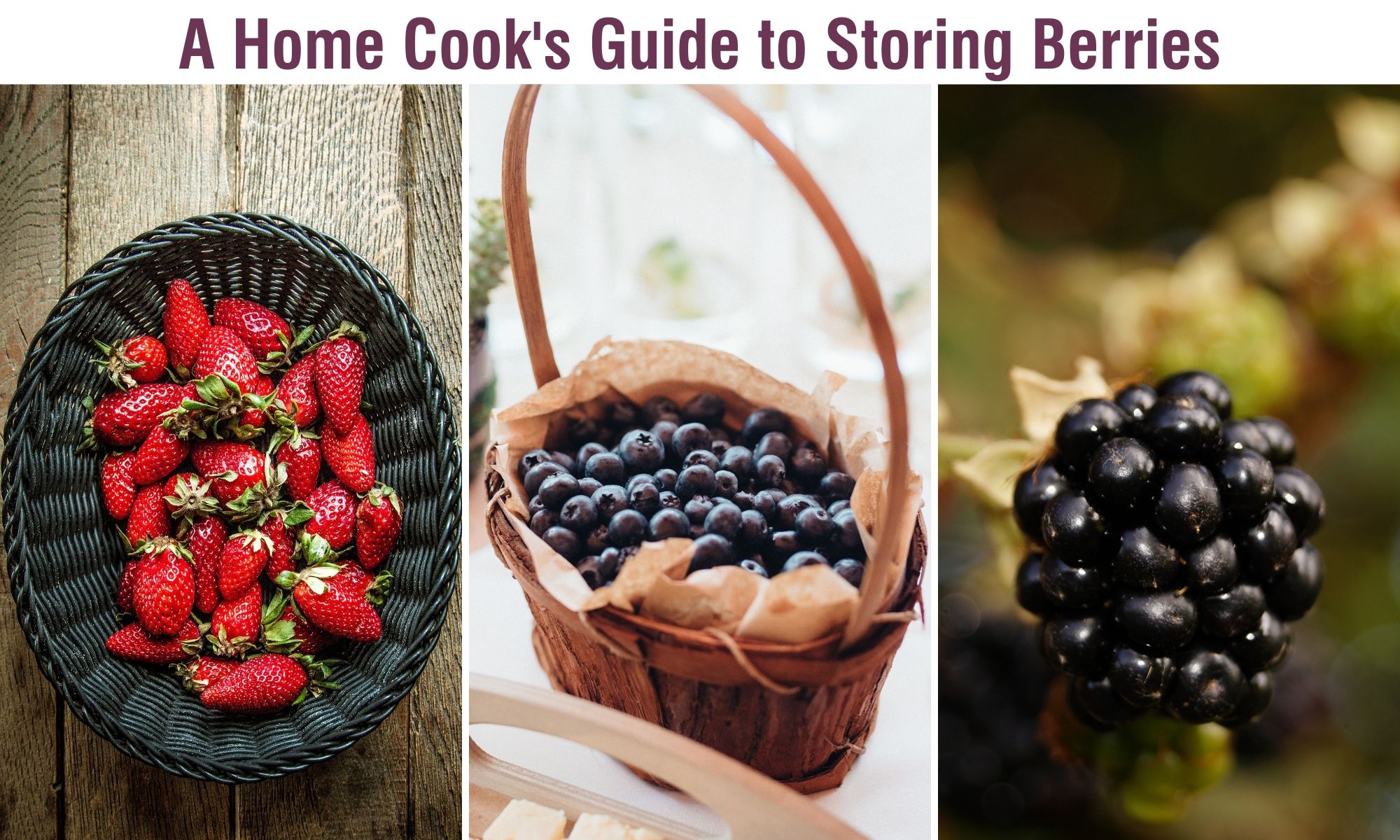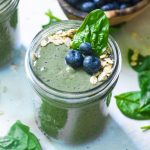Some berries continue to ripen after picking while others do not. Keep yourself from low-quality or spoiled berries with this comprehensive guide on how to store berries. Plus, some unique and delicious recipes to use your berries with.

Berries are the ultimate summer flavor. They're bursting with sun-kissed warmth and juicy ripeness that announces that you should be outside enjoying the sun.
Well, most of them anyway.
No matter the berry, however, they tend to be finicky about how they are stored. Almost like avocados. You think you have it mastered, and you get it all planned for when you are going to use them, only to go to the fridge and find them molded.
Keep reading to understand all the nuances of why, the proper way to store berries, as all my best chef tips for keeping them fresher longer.
When Are Berries In Season?
Depending on what berry you are talking about and where you live the season will range.
Most standard “berries” (technically, persimmons and grapes qualify) are in season from around May until September.
Thankfully, most grocery stores provide you with a way to enjoy these tasty fruits year-round, just at a slightly higher premium than when they are in season.
Commercial Growing Practices
Over the years, the way berries are grown has changed significantly. They aren’t often bred with flavor in mind, but rather, the ability to stay fresh for a long time after they are picked.
Since many mass-produced berries have to be flown all over the world for sale, this often means that you aren’t getting the most extraordinarily flavorful berries.
Going local with your berries means that you’re more likely to get a better-tasting berry, it just may not be as pretty.
For example, mass-produced berries are also often grown for their appearance: big, symmetrical, and consistent. The lesser-used, more heirloom varieties are often oddly shaped, inconsistent, and small. These aren’t indicators of a bad crop, they’re indicators of real food.
This is an important factor to consider when deciding how to store berries because the local heirloom varieties will have a shorter shelf life than the mass-produced ones.
Fun fact: Size does not determine flavor when buying berries. The smaller your berries are, the sweeter and more flavorful they tend to be because the taste is more concentrated.
How To Know If Berries Are Ripe
When it comes to how to store berries, regardless of the type of berry, the five most important things to look for are texture, color, the containers they are stored in, the smell, and potential mold.
Your berries should be:
- Firm. If you give them a small squeeze, they should be firm. If they give too easily under the pressure, they are probably starting to get old.
- Color. They should be bright in color and a little bit shiny. If you notice blemishes, or if they look a little hazy, they are reaching the end of their prime.
- Dry Containers. If you are buying them in the cardboard containers, make sure that the container is mostly dry. If it is soaked that means that some of the berries at the bottom of the container are smashed and/or going bad.
- Smell. They should smell fresh and sweet. If you smell something resembling wine or vinegar, then some of the berries in the container have turned bad and you need to choose a different container.
- Mold. Don’t just check on top of the berries, feel free to move some of the them around in the packaging and check for mold between them as well. If you're getting berries that have hollow insides, like raspberries, double check in the cavity because mold likes to hang out there.
Fun fact: Color helps determine ripeness. As a rule of thumb, the deeper the color of the berry, the sweeter it will be. (Name the musical that sings about this!)
Picking Fresh Berries
My very favorite way to acquire berries is through u-pick farms. These farms let you pick the fruits yourself and pay a significantly lower by-the-pound price than the store.
Always make sure to call ahead to confirm that there is plenty for the picking; most of these farms also sell at Farmer’s Markets and roadside stands and might be picked over before you go.
I also recommend asking what variety of berry (Totem, Hood, or Tillamook strawberries for example) they have available for picking because some may be sweeter than others, or facing particular difficulties that season.
If you don’t have the time to drive to a farm for a u-pick, some farmers will work out a “club” program where you prepay for a certain amount of berries. Then they choose them for you and you pick them up when they are available.
This usually lands you somewhere in the ballpark price range of less than the grocery store, but more than a u-pick.
Fun fact: Most berries, except strawberries, continue to ripen after picking. This means they can quickly gain flavor or quickly go bad.
Tips For How To Store Berries In The Fridge
We’ve all had those moments where we go to sit and down and enjoy the berries we bought earlier in the week, only to find that they’ve gone bad. That was a quick $4+ out the window! Here are my favorite tips for how to store berries.
- Washing. A lot of people like to wash all their produce at once when they get home from the market, but this can actually damage delicate berries. Only wash them by gently rinsing them in a colander right before you are ready to use them. TIP: Berries hold up better to washing if you chill them in the refrigerator for a bit first.
- Air. There is a reason that most packaging has holes; it’s for air circulation. The more restricted the berries are, the greater the chance of spoilage. Store them in a specially-desgined container, colander, or bowl that allows air to move freely around the fruit.
- Overlapping. Just like with air circulation, the more restricted the berry is, the greater the chance of spoilage. So, if you have room to spread them out so the berries don't touch they are more likely to last longer. Not only because they have air, but because mold can’t spread from one berry to another. If you notice that they are starting to mold, this is a great way to help them last an extra day or two.
- Location, location, location. Storing your berries in the refrigerator will help delay spoilage, but where you set them in fridge can also make a difference. The humidity of the crisper drawer prevents proper air flow, so make sure to set them on a shelf instead.
How To Wash Berries
Since moisture is the enemy of berries, make sure not to wash them until right before you are ready to use them or freeze them.
To wash berries:
Remove the berries from the original carton and rinse them in a vinegar bath of 1 part white vinegar and 3 parts water for 30 seconds. Just gently stir them around with your hands to help release the unwanted debris.
Don't worry, this doesn't make your berries taste like vinegar, but it does help kill potential mold spores and bacteria.
Once the berries are rinsed, make sure they are completely dry before freezing, refrigerating, or using.
Storing Strawberries
Strawberries are probably the most common mass-produced berry out there. Whether you are using them for Valentine's Day chocolate-dipped strawberries, pie, or shortcake, you want them to be in top-notch shape.
Store the strawberries refrigerated in a berry container that has airflow for up to a week. Avoid keeping them at room temperature for any length of time and sort through to remove any damaged berries before refrigerating.
To freeze strawberries, rinse the berries according to the method above. Next, remove the stems according to your favorite method. (If you need a good tool, I recommend this strawberry huller.)
Place each berry on a baking sheet trying to reduce the amount that they touch as much as possible. Place the sheet pan in the freezer and freeze for 1-2 hours or until the outside is hardened.
Transfer the berries to an airtight container and store the frozen strawberries in an airtight container for up to one year.
Storing Blueberries
Blueberries are a surprisingly hardy berry due to their firm skin. Similar to storing apples, blueberries don't tend to go bad until they are exposed to another berry that is bad.
To store blueberries, refrigerate them on a shelf in their original container or a berry container that has airflow. Check them regularly for any berries that are spoiling and remove them immediately to prevent the spread of mold.
Right before using, rinse under cool water or use the method described above.
Blueberries stored like this should last up to two weeks in the refrigerator.
Do not put blueberries in the crisper drawer or an airtight container because the trapped moisture will promote spoilage.
To freeze blueberries, wash them according to the instructions above, then rinse them off and pat them completely dry.
Place each berry on a baking sheet trying to reduce the amount that they touch as much as possible. Place the sheet pan in the freezer and freeze for 1-2 hours or until the outside is hardened.
Transfer the frozen blueberries to an airtight container and store them for up to one year.
TIP: This method also works for huckleberries/bilberry, gooseberries, elderberries, currants, saskatoon/juneberry, and lingonberries.
Storing Raspberries
Raspberries are the most delicate of the common berries. Their hollow center makes them more likely to get damaged or lose structure. As a result, they need a little more tender loving care in their storage.
To store raspberries, place them on a shelf in the refrigerator in their original container or your own breathable berry container. Rinse them right before using the method detailed above, making sure to get the cavity.
Raspberries stored this way should last 2-4 days.
If you can, separate the berries into a single layer. This may extend the shelf life by a day or two.
This helps because there isn't any pressure from other berries squishing the raspberries down and forcing out the juice. This juice then creates moisture that promotes spoilage.
To freeze raspberries, wash them with the method from above. Rinse them off and pat them completely dry.
Place each berry on a baking sheet trying to reduce the amount that they touch as much as possible. Place the sheet pan in the freezer and freeze for 1-2 hours or until the outside is hardened.
Transfer the frozen raspberries to an airtight container and store them for up to one year.
TIP: This method also works with loganberries, black raspberries, salmonberries, mulberries, and tayberries.
Storing Blackberries
Blackberries are juicy berries that have a unique texture as the result of the fruit and seed being together. They do, however, have a very short shelf life and can go bad quickly so avoid keeping them at room temperature for any length of time.
To store fresh blackberries in the refrigerator, leave them in their original container or transfer them to a special berry container that promotes airflow. Store them loosely packed on a shelf, not in a drawer, for best results.
If you have a lot of blackberries to store, place a paper towel between each layer to catch any leaking juices. This helps reduce the moisture directly touching the berries and prevents molding.
Blackberries stored correctly should last you 2-5 days.
To freeze blackberries, wash them according to the instructions above then make sure they are completely dry.
Place each berry on a baking sheet trying to reduce the amount that they touch as much as possible. Place the sheet pan in the freezer and freeze for 1-2 hours or until the outside is hardened.
Transfer the frozen blackberries to an airtight container and store them for up to one year.
Tip: This method also works for marionberries, boysenberries, cloudberries, and dewberries.
Storing Cranberries
Similar to blueberries, cranberries have firm skin that protects them. Unlike any of the previously mentioned berries though, they do not have a soft interior, the whole berry is firm, which means that it is longer lasting than others.
Although the berry is more acidic than sweet, cranberries have many uses, especially for holiday recipes.
Fresh cranberries need to be refrigerated in shallow containers with some room for air circulation to allow moisture to escape. But due to their hard exterior, they don't need the hard-shell containers like other berries, but instead are sold in flexible bags.
Fresh cranberries last up to one month from purchase. You know they are going bag if they begin to look dull, become soft and squishy, or are wrinkly.
Frozen cranberries last 9-12 months.
Tip: This also works with caperberries and bearberries.
Berry Recipes
Now that you know how to store berries correctly, you need to eat them. Berry recipes go far beyond just smoothies and muffins. Try some of these fun variations on both sweet and savory berry recipes.
Strawberry Recipes


Blueberry Recipes





Raspberry Recipes




Blackberry Recipes

Cranberry Recipes

Want even more berry recipes? Try these:
- Goldenberry Burrata Salad by This Healthy Table
- Mulberry Mojitos by Babaganosh
- Huckleberry Pie by State of Dinner
- Lingonberry Jam by Masala Herb
- Partridgeberry Muffins by Crumb Top Baking



What are your thoughts?